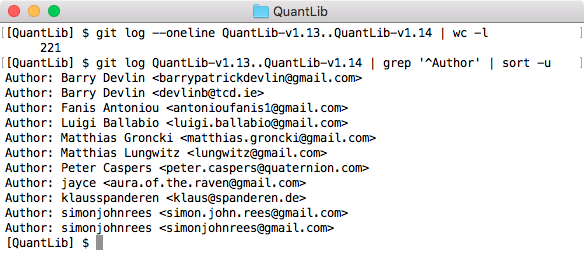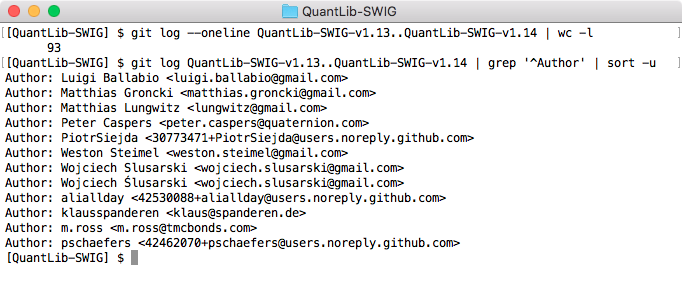A quick look at the QuantLib 1.14 release
Hello everybody.
Last Monday, October 1st, I’ve released QuantLib 1.14. Here’s my usual look at some statistics. (I’ll wait if you want to go download it first: it’s available from the QuantLib site.)
This release comes slightly more than four months after 1.13—about par from the course—and contains 40 pull requests, which are a couple less than last release and 14 less than the one before; the full list is here. The number of contributors dropped, too; it went from the 13 of the previous release to the 9 of this one. It might have been the summer period right in the middle of the four months, but that’s only conjecture. We’ll see how we do next time. As usual, this doesn’t include all the people that reported bugs and suggested improvements; kudos to them, too. (Oh, and the number of commits was 221; those increased, at least.)

This release also marks the beginning of a long path towards a move to
C++11 at some point in the future. I started wrapping some of the
features we’re taking from Boost into an inner namespace
QuantLib::ext, as I described in a previous post. This allowed me to add a
compilation switch that lets you use std::shared_ptr and its related
classes instead of boost::shared_ptr. Another switch replaces the
deprecated std::auto_ptr with std::unique_ptr. You can read about
them in the
release notes;
of course, you’ll need to compile at least in C++11 mode for them to
work.
I’ll probably be adding similar switches for boost::function and
boost::bind in the future. And if you’re interested in a proof of
concept for the migration, you can read
my Leaving C++03 series.
As for QuantLib-SWIG, this release includes 19 pull requests from 11 contributors, adding up to 93 commits.

And if you want to be among the contributors from next release, this is the right time; the fifth edition of Hacktoberfest just started, and you might get a nice t-shirt for your contributions open-source projects. I’ve marked a few issues from the QuantLib repo as a suggestion, but you can submit any change you like. I look forward to it.
Subscribe to my Substack to receive my posts in your inbox, or follow me on Twitter or LinkedIn if you want to be notified of new posts, or subscribe via RSS if you’re the tech type: the buttons for all that are in the footer. Also, I’m available for training, both online and (when possible) on-site: visit my Training page for more information.